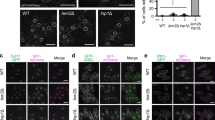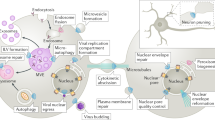Abstract
The elucidation of the organization and maintenance of the plasma membrane has been sought due to its numerous roles in cellular function. In the budding yeast Saccharomyces cerevisiae, a novel paradigm has begun to emerge in the understanding of the distribution of plasma membrane microdomains and how they are regulated. We aimed to investigate the dynamic interdependence between the protein complexes eisosome and TORC2, representing microdomains MCC and MCT, respectively. In this study, we reveal that the eisosome organizer Pil1 colocalizes with the MCT marker Avo2. Furthermore, we provide evidence that the formation of MCT is dependent on both eisosome integrity and adequate levels of the plasma membrane phosphoinositide PI(4,5)P2. Taken together, our findings indicate that TORC2, eisosomes, and PI(4,5)P2 exist in an interconnected relationship, which supports the emerging model of the plasma membrane.




Similar content being viewed by others
References
Aguilar PS, Frohlich F, Rehman M, Shales M, Ulitsky I, Olivera-Couto A, Braberg H, Shamir R, et al. 2010 A plasma-membrane E-MAP reveals links of the eisosome with sphingolipid metabolism and endosomal trafficking. Nat. Struct. Mol. Biol. 17 901–908
Audhya A, Loewith R, Parsons AB, Gao L, Tabuchi M, Zhou H, Boone C and Hall MN 2004 Genome-wide lethality screen identifies new PI4,5P2 effectors that regulate the actin cytoskeleton. EMBO J. 23 3747–3757
Bartlett K and Kim K 2014 Insight into Tor2, a budding yeast microdomain protein. Eur. J. Cell Biol. 93 87–97
Berchtold D, Piccolis M, Chiaruttini N, Riezman I, Riezman H, Roux A, Walther TC and Loewith R 2012 Plasma membrane stress induces relocalization of Slm proteins and activation of TORC2 to promote sphingolipid synthesis. Nat. Cell Biol. 14 542–547
Berchtold D and Walther TC 2009 TORC2 plasma membrane localization is essential for cell viability and restricted to a distinct domain. Mol. Biol. Cell 20 1565–1575
Brach T, Specht T and Kaksonen M 2011 Reassessment of the role of plasma membrane domains in the regulation of vesicular traffic in yeast. J. Cell Sci. 124 328–337
Campbell RE, Tour O, Palmer AE, Steinbach PA, Baird GS, Zacharias DA and Tsien RY 2002 A monomeric red fluorescent protein. Proc. Natl. Acad. Sci. U. S. A. 99 7877–7882
Chen DC, Yang BC and Kuo TT 1992 One-step transformation of yeast in stationary phase. Curr. Genet. 21 83–84
Chiantia S and London E 2013 Sphingolipids and membrane domains: recent advances. Handb. Exp. Pharmacol. 33–55.
Cornu M, Albert V and Hall MN 2013 mTOR in aging, metabolism, and cancer. Curr. Opin. Genet. Dev. 23 53–62
Cybulski N and Hall MN 2009 TOR complex 2: a signaling pathway of its own. Trends Biochem. Sci. 34 620–627
deHart AK, Schnell JD, Allen DA, Tsai JY, and Hicke L 2003 Receptor internalization in yeast requires the Tor2-Rho1 signaling pathway. Mol. Biol. Cell. 14, 4676–4684
Delage E, Puyaubert J, Zachowski A and Ruelland E 2013 Signal transduction pathways involving phosphatidylinositol 4-phosphate and phosphatidylinositol 4,5-bisphosphate: convergences and divergences among eukaryotic kingdoms. Prog. Lipid Res. 52 1–14
Desrivieres S, Cooke FT, Parker PJ and Hall MN 1998 MSS4, a phosphatidylinositol-4-phosphate 5-kinase required for organization of the actin cytoskeleton in Saccharomyces cerevisiae. J. Biol. Chem. 273 15787–15793
Dickson RC 2010 Roles for sphingolipids in Saccharomyces cerevisiae. Adv. Exp. Med. Biol. 688 217–231
Fadri M, Daquinag A, Wang S, Xue T and Kunz J 2005 The pleckstrin homology domain proteins Slm1 and Slm2 are required for actin cytoskeleton organization in yeast and bind phosphatidylinositol-4,5-bisphosphate and TORC2. Mol. Biol. Cell 16 1883–1900
Friant S, Lombardi R, Schmelzle T, Hall MN and Riezman H 2001 Sphingoid base signaling via Pkh kinases is required for endocytosis in yeast. EMBO J. 20 6783–6792
Frohlich F, Moreira K, Aguilar PS, Hubner NC, Mann M, Walter P and Walther TC 2009 A genome-wide screen for genes affecting eisosomes reveals Nce102 function in sphingolipid signaling. J. Cell Biol. 185 1227–1242
Grossmann G, Malinsky J, Stahlschmidt W, Loibl M, Weig-Meckl I, Frommer WB, Opekarova M and Tanner W 2008 Plasma membrane microdomains regulate turnover of transport proteins in yeast. J. Cell Biol. 183 1075–1088
Grossmann G, Opekarova M, Malinsky J, Weig-Meckl I and Tanner W 2007 Membrane potential governs lateral segregation of plasma membrane proteins and lipids in yeast. EMBO J. 26 1–8
Helliwell SB, Wagner P, Kunz J, Deuter-Reinhard M, Henriquez R and Hall MN 1994 TOR1 and TOR2 are structurally and functionally similar but not identical phosphatidylinositol kinase homologues in yeast. Mol. Biol. Cell 5 105–118
Kabeche R, Roguev A, Krogan NJ and Moseley JB 2014 A Pil1-Sle1-Syj1-Tax4 functional pathway links eisosomes with PI(4,5)P2 regulation. J. Cell Sci. 127 1318–1326
Karotki L, Huiskonen JT, Stefan CJ, Ziolkowska NE, Roth R, Surma MA, Krogan NJ, Emr SD, et al. 2011 Eisosome proteins assemble into a membrane scaffold. J. Cell Biol. 195 889–902
Kim K, Galletta BJ, Schmidt KO, Chang FS, Blumer KJ and Cooper JA 2006 Actin-based motility during endocytosis in budding yeast. Mol. Biol. Cell 17 1354–1363
Klotzsch E and Schutz GJ 2013 A critical survey of methods to detect plasma membrane rafts. Philos. Trans. R. Soc. Lond. B Biol. Sci. 368 20120033
Kunz J, Henriquez R, Schneider U, Deuter-Reinhard M, Movva NR and Hall MN 1993 Target of rapamycin in yeast, TOR2, is an essential phosphatidylinositol kinase homolog required for G1 progression. Cell 73 585–596
Laplante M and Sabatini DM 2009 mTOR signaling at a glance. J. Cell Sci. 122 3589–3594
Liu K, Zhang X, Sumanasekera C, Lester RL and Dickson RC 2005 Signalling functions for sphingolipid long-chain bases in Saccharomyces cerevisiae. Biochem. Soc. Trans. 33 1170–1173
Loewith R, Jacinto E, Wullschleger S, Lorberg A, Crespo JL, Bonenfant D, Oppliger W, Jenoe P, et al. 2002 Two TOR complexes, only one of which is rapamycin sensitive, have distinct roles in cell growth control. Mol. Cell 10 457–468
Longtine MS, McKenzie A 3rd, Demarini DJ, Shah NG, Wach A, Brachat A, Philippsen P and Pringle JR 1998 Additional modules for versatile and economical PCR-based gene deletion and modification in Saccharomyces cerevisiae. Yeast (Chichester, England) 14 953–961
Luo G, Gruhler A, Liu Y, Jensen ON and Dickson RC 2008 The sphingolipid long-chain base-Pkh1/2-Ypk1/2 signaling pathway regulates eisosome assembly and turnover. J. Biol. Chem. 283 10433–10444
Malinska K, Malinsky J, Opekarova M and Tanner W 2003 Visualization of protein compartmentation within the plasma membrane of living yeast cells. Mol. Biol. Cell 14 4427–4436
Malinsky J, Opekarova M and Tanner W 2010 The lateral compartmentation of the yeast plasma membrane. Yeast (Chichester, England) 27 473–478
Mollinedo F 2012 Lipid raft involvement in yeast cell growth and death. Front Oncol. 2 140
Moreira KE, Walther TC, Aguilar PS and Walter P 2009 Pil1 controls eisosome biogenesis. Mol. Biol. Cell 20 809–818
Murphy ER, Boxberger J, Colvin R, Lee SJ, Zahn G, Loor F and Kim K 2011 Pil1, an eisosome organizer, plays an important role in the recruitment of synaptojanins and amphiphysins to facilitate receptor-mediated endocytosis in yeast. Eur. J. Cell Biol. 90 825–833
Nannapaneni S, Wang D, Jain S, Schroeder B, Highfill C, Reustle L, Pittsley D, Maysent A, et al. 2010 The yeast dynamin-like protein Vps1:vps1 mutations perturb the internalization and the motility of endocytic vesicles and endosomes via disorganization of the actin cytoskeleton. Eur. J. Cell Biol. 89 499–508
Niles BJ, Joslin AC, Fresques T and Powers T 2014 TOR complex 2-Ypk1 signaling maintains sphingolipid homeostasis by sensing and regulating ROS accumulation. Cell Rep. 6 541–552
Olivera-Couto A, Grana M, Harispe L and Aguilar PS 2011 The eisosome core is composed of BAR domain proteins. Mol. Biol. Cell 22 2360–2372
Pfaffl MW 2001 A new mathematical model for relative quantification in real-time RT-PCR. Nucleic Acids Res. 29 e45
Pike LJ 2006 Rafts defined: a report on the Keystone Symposium on Lipid Rafts and Cell Function. J. Lipid Res. 47 1597–1598
Schmidt A, Kunz J and Hall MN 1996 TOR2 is required for organization of the actin cytoskeleton in yeast. Proc. Natl. Acad. Sci. U. S. A. 93 13780–13785
Shimobayashi M and Hall MN 2014 Making new contacts: the mTOR network in metabolism and signalling crosstalk. Nat. Rev. Mol. Cell Biol. 15 155–162
Simons K and Sampaio JL 2011 Membrane organization and lipid rafts. Cold Spring Harb. Perspect. Biol. 3 a004697
Spira F, Mueller NS, Beck G, von Olshausen P, Beig J and Wedlich-Soldner R 2012 Patchwork organization of the yeast plasma membrane into numerous coexisting domains. Nat. Cell Biol. 14 640–648
Stefan CJ, Audhya A and Emr SD 2002 The yeast synaptojanin-like proteins control the cellular distribution of phosphatidylinositol (4,5)-bisphosphate. Mol. Biol. Cell 13 542–557
Stradalova V, Stahlschmidt W, Grossmann G, Blazikova M, Rachel R, Tanner W and Malinsky J 2009 Furrow-like invaginations of the yeast plasma membrane correspond to membrane compartment of Can1. J. Cell Sci. 122 2887–2894
Sturgill TW, Cohen A, Diefenbacher M, Trautwein M, Martin DE and Hall MN 2008 TOR1 and TOR2 have distinct locations in live cells. Eukaryot. Cell 7 1819–1830
Sun Y, Taniguchi R, Tanoue D, Yamaji T, Takematsu H, Mori K, Fujita T, Kawasaki T, et al. 2000 Sli2 (Ypk1), a homologue of mammalian protein kinase SGK, is a downstream kinase in the sphingolipid-mediated signaling pathway of yeast. Mol. Cell. Biol. 20 4411–4419
Tenay B, Kimberlin E, Williams M, Denise J, Fakilahyel J and Kim K 2013 Inactivation of Tor proteins affects the dynamics of endocytic proteins in early stage of endocytosis. J. Biosci. 38 351–361
Walther TC, Aguilar PS, Frohlich F, Chu F, Moreira K, Burlingame AL and Walter P 2007 Pkh-kinases control eisosome assembly and organization. EMBO J. 26 4946–4955
Walther TC, Brickner JH, Aguilar PS, Bernales S, Pantoja C and Walter P 2006 Eisosomes mark static sites of endocytosis. Nature 439 998–1003
Wullschleger S, Loewith R, Oppliger W and Hall MN 2005 Molecular organization of target of rapamycin complex 2. J. Biol. Chem. 280 30697–30704
Acknowledgements
We would like to thank Michael Hall (University of Basel) for providing tor mutant strains (tor1Δ, and tor2 ts); Scott Emr (Cornell University) for mutant strain (mss4 ts); Paul Schweiger for his assistance with statistical analysis; Leah Cardwell for assistance with RTq-PCR; and Michelle Williams for helpful discussion. This work was supported by a National Scientific Foundation Grant 0923024 (to KK) and by thesis funding from Missouri State University (KB).
Author information
Authors and Affiliations
Corresponding author
Additional information
Corresponding editor: Amit Chattopadhyay
[Bartlett K, Gadila SKG, Tenay B, McDermott H, Alcox B and Kim K 2015 TORC2 and eisosomes are spatially interdependent, requiring optimal level of phosphatidylinositol 4, 5-bisphosphate for their integrity. J. Biosci. 40 1–13] DOI 10.1007/s12038-015-9526-4
Supplementary materials pertaining to this article are available on the Journal of Biosciences Website at http://www.ias.ac.in/jbiosci/jun2015/supp/Bartlett.pdf
Electronic supplementary material
Below is the link to the electronic supplementary material.
ESM 1
(PDF 601 KB)
Rights and permissions
About this article
Cite this article
Bartlett, K., Gadila, S.K.G., Tenay, B. et al. TORC2 and eisosomes are spatially interdependent, requiring optimal level of phosphatidylinositol 4, 5-bisphosphate for their integrity. J Biosci 40, 299–311 (2015). https://doi.org/10.1007/s12038-015-9526-4
Received:
Accepted:
Published:
Issue Date:
DOI: https://doi.org/10.1007/s12038-015-9526-4




